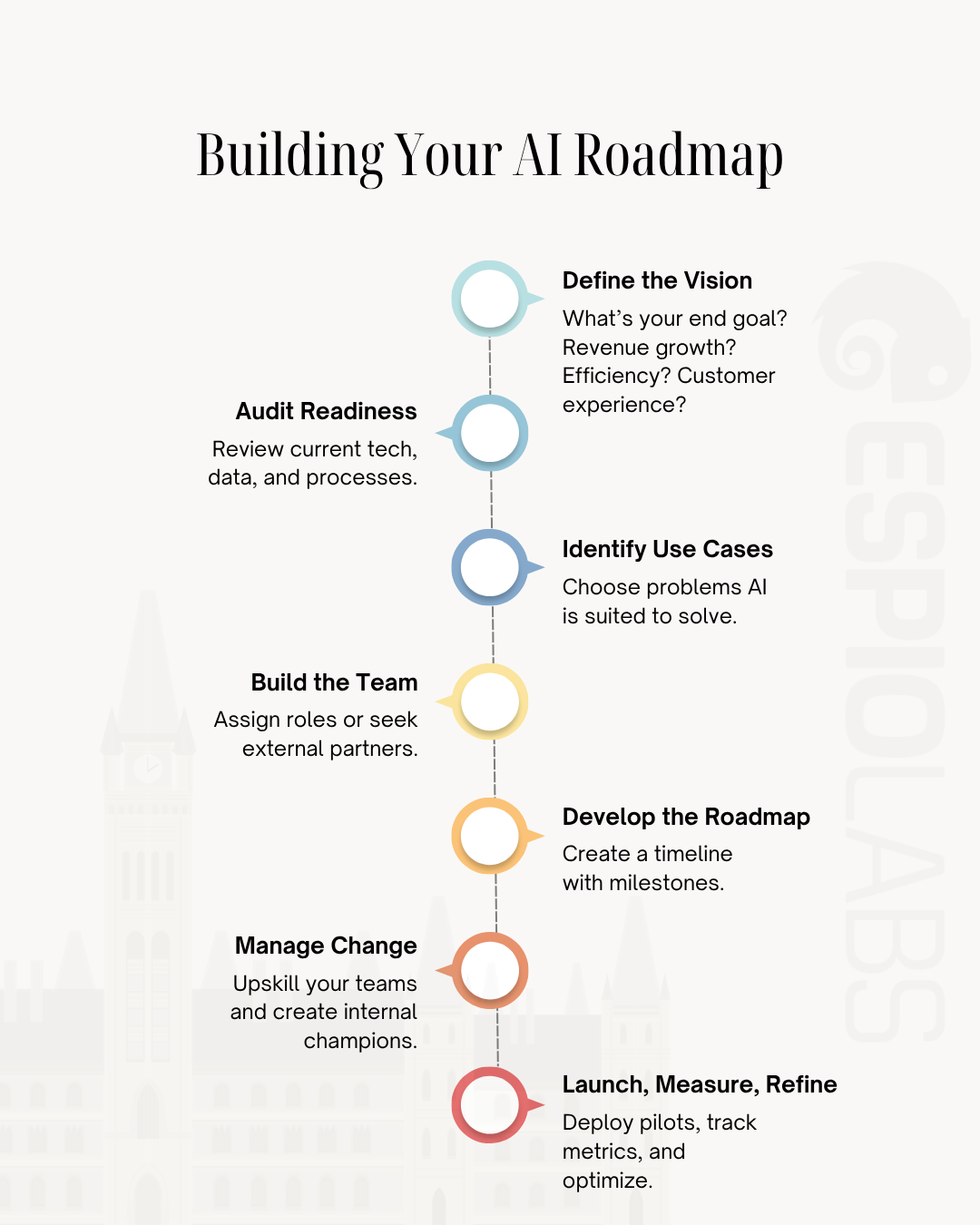From Strategy to Execution: Building an AI Roadmap for Your Business
Do you know if your business has a clear AI roadmap, or are you still trying to figure out where to begin?
AI is no longer just hype. It provides tangible benefits to operations, customer experience, and the decision-making process. Yet, many businesses are caught off guard by how fast technology evolves. Without a proper plan and actionable AI business strategy, you’re not just missing out; you’re falling behind.
In this post, you’ll learn what exactly you need inside an AI roadmap, why you need one, and how to build one that aligns with your business goals. You’ll also get a better overall picture of the real benefits and get a look into what’s next for AI strategy.
If you want to remain ahead of the pack, keep reading.
Table of Contents:
What Is an AI Roadmap and Why Your Business Needs One
Core Components of an Effective AI Business Strategy
Step-by-Step: How to Build Your AI Roadmap
Benefits of a Defined AI Strategy Roadmap
Where AI Business Strategies Are Heading Next
What Is an AI Roadmap and Why Your Business Needs One
Think of your AI roadmap as a strategic blueprint that aligns AI initiatives with your operational priorities. It dictates where to deploy AI so that it can deliver the most value by laying out steps for implementation and sets clear milestones. Without this roadmap, your AI projects may lack guidance, stall, or waste valuable resources.
Why AI is a Strategic Necessity, Not Just a Tech Decision
Artificial Intelligence is now a trending boardroom topic and companies across all industries, from finance to logistics, are looking for various avenues to integrate AI within their business processes.
If your competition is adopting AI with a defined roadmap, and you’re not, your business is at risk of being at a significant disadvantage.
This isn’t speculation. It’s already happening.
According to McKinsey, AI leaders are capturing significantly more value than those still dabbling in pilots.
Need an AI strategy team to help you map it out?
EspioLabs offers full-service AI advisory and implementation support.
Read More: Harvard Business School outlines the value of a robust AI business strategy, especially for organizations that want long-term scalability and efficiency. Learn more.
Core Components of an Effective AI Business Strategy
A strong AI strategy is more than simply picking the right tools. It requires certain organizational technology readiness levels, executive alignment, and a scalable implementation model.
Key Components of an AI Roadmap: Quick Reference Checklist
| Component | Description |
| Business Alignment | Ties each AI initiative to clear, measurable business goals. |
| Data Infrastructure | Ensures clean, accessible, and integrated data sources for training models. |
| AI Talent/Partnerships | Internal teams or third-party experts to lead and support implementation. |
| Governance | Includes ethical guidelines, compliance standards, and risk controls. |
| Scalability Plan | Designs AI solutions with future expansion and reuse in mind. |
Aligning AI With Your Business Objectives
One of the most common pitfalls in AI adoption is starting with the tech instead of the problem. Your roadmap should begin by identifying high-value business challenges, then exploring how AI can solve them.
Use case examples include customer segmentation, demand forecasting, automated document processing, and fraud detection. Each of these should be validated through a cost-benefit analysis.
Need help connecting AI use cases to your business needs?
Get in touch so that our team in Ottawa can walk you through the AI deployment process.
Step-by-Step: How to Build Your AI Roadmap

Step 2: Audit Readiness: Review current tech, data, and processes.
Step 3: Identify Use Cases: Choose problems AI is suited to solve.
Step 4: Build the Team: Assign roles or seek external partners.
Step 5: Develop the Roadmap: Create a timeline with milestones.
Step 6: Manage Change: Upskill your teams and create internal champions.
Step 7: Launch, Measure, Refine: Deploy pilots, track metrics, and optimize.
Pipedrive offers a helpful AI business strategy guide outlining a structured approach many mid-sized businesses can follow.
A common theme among successful implementations? Leadership buy-in and cross-functional collaboration. Treat it like a digital transformation project and not simply a software deployment.
Benefits of a Defined AI Strategy Roadmap
Having a clearly defined roadmap gives you the chance to:
- Avoid aimless experimentation
- Speed up implementation
- Track ROI with real benchmarks
Let’s take a look at the main benefits:
1. Competitive Advantage
An AI roadmap helps your business stay ahead by focusing resources on high-impact opportunities. You move from reacting to leading.
Being AI-powered means faster decisions, better customer interactions and smoother business operations. With a structured approach (or roadmap), you’ll capitalize more effectively on emerging tech instead of playing catch-up.
2. Cost Control and Efficiency
By prioritizing AI projects based on ROI (Return on Investment), companies reduce time wasted and gain measurable results. A roadmap reduces trial-and-error by focusing on tested solutions and repeatable processes.
AI automation can cut manual processing times in half, boost data accuracy, and reduce overhead. For instance, PwC’ 2025 AI Predictions states that, “adopting AI in R&D can reduce time-to-market 50% and lower costs 30% in industries like automotive and aerospace. In many pharmaceutical companies, AI has already helped reduce drug discovery timelines by over 50%.”
That kind of scale only happens when your initiatives are mapped out in advance. Our advisory team helps companies plan for impact.
3. Business Resilience and Futureproofing
An AI roadmap positions your business to adapt to disruption. Whether it’s economic shifts, evolving customer needs, or new regulations, companies who implement AI into their core processes react faster and smarter.
For example, Microsoft’s cloud-powered AI strategy for financial services showcases how scalable infrastructure plus smart governance equals long-term resilience.
Not sure how to get started with AI? EspioLabs can help you find the right strategic entry point.
Where AI Business Strategies Are Heading Next
Looking ahead, we’re seeing the rise of:
- AI governance standards
- Autonomous decision-making models
- Personalized AI assistants for business functions
These trends are reshaping not just how we use AI, but how we plan for it. According to Gartner, by 2026, over 80% of large enterprises will have a formal AI governance framework in place, underlining the urgency for forward-thinking strategies and continuous roadmap refinement.
Companies that embrace continuous AI strategy evolution will maintain their competitive advantage. Those that don’t will find themselves scrambling to keep up will be at a costly disadvantage right from the start.
The Future Belongs to the Bold
The future belongs to businesses that are ready to think differently, act boldly, and execute intelligently. AI isn’t tomorrow’s advantage; it’s today’s.
